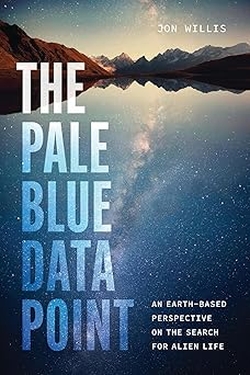Centauri Dreams
Imagining and Planning Interstellar Exploration
Two Planets Around Nearby Gliese 887
Red dwarf stars have fascinated me for decades, ever since I learned that a potentially habitable planet around one might well be tidally locked. Trying to imagine a living world with a sun that didn’t move in the sky was the kind of exercise that I love about science fiction, where playing with ideas always includes a vivid visual element. What kind of landscapes would a place like this offer to the view? What kind of weather would tidal lock conjure? Stephen Baxter’s novel Proxima (Ace, 2014) is a wonderful exercise in such world-building.
Thus my continuing interest in the splendid work being done by RedDots, which takes as its charter the detection of terrestrial planets orbiting red dwarfs near the Sun. You’ll recall that this is the team that discovered Proxima Centauri b, a star under increased scrutiny of late as other potential planetary signals are examined. RedDots also gave us Barnard’s Star b and has found three planets around the red dwarf GJ 1061.
Now we learn about a system of super-Earths orbiting nearby Gliese 887, which is the brightest red dwarf in our sky (as per RECONS, the Research Consortium On Nearby Stars). More massive than the Earth but smaller than the ice giants in our system, the two worlds may or may not be rocky — this is radial velocity work, so we have only minimum mass figures to work with. The minimum masses reported in the paper in Science are 4.2 ± 0.6 and 7.6 ± 1.2 Earth masses (M?). My guess is that these planets are more like Neptune than Earth, but we’ll see.
The RedDots team found the two planets using the HARPS spectrograph at the European Southern Observatory in Chile. There is also an unconfirmed signal with a period of roughly 50 days, possibly a third planet of a similar mass, but note this: “We regard the third signal at ~50 days as dubious and likely related to stellar activity.”

Lead author of the paper is Sandra Jeffers (University of Göttingen), who notes the opportunity this system provides astronomers for follow-up work. The two planets have orbital periods of 9.3 and 21.8 days respectively and circle a star that is about 11 light years away. A space-based observatory might be able to tease out their reflected light. From the paper:
GJ 887 has the brightest apparent magnitude of any known M dwarf planet host. This brightness, combined with the high photometric stability of GJ 887, exhibited in the TESS data, and the high planet-star brightness and radius ratios, make these planets potential targets for phased-resolved photometric studies, especially in emission. Spectrally resolved phase photometry has been shown to be sensitive to the presence of an atmosphere and molecules such as CO2.
Image: Dr Sandra Jeffers. Credit: University of Göttingen.
The team believes that the star has few starspots:
The TESS variability can be explained by one starspot, or a group of starspots, with a total diameter of 0.3% of the stellar surface, indicating that GJ 887 is slowly rotating with very few surface brightness inhomogeneities.
And that’s interesting because it implies a lower value for the star’s stellar wind, which could cause planetary atmospheres to erode and, if strong enough, conceivably strip them altogether. Thus the likelihood that there may be atmospheres on these planets, which renders them interesting potential targets for the who-knows-when-it-will-fly James Webb Space Telescope.
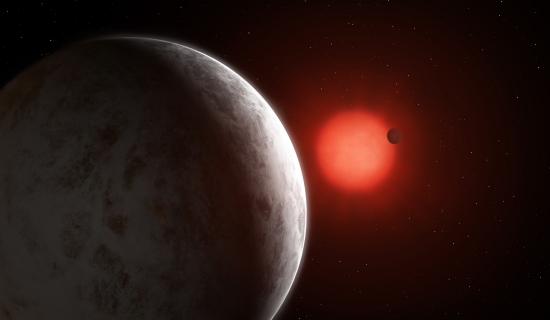
Image: Artist’s impression of the multiplanetary system of newly discovered super-Earths orbiting nearby red dwarf Gliese 887. Credit: Mark Garlick.
The paper is Jeffers et al., “A multiplanet system of super-Earths orbiting the brightest red dwarf star GJ 887,” Science Vol. 368, Issue 6498 (26 June 2020), pp. 1477-1481 (abstract).

A 20th Anniversary Review of Ward and Brownlee’s ‘Rare Earth’
Ramses Ramirez, whose work on what he calls the Complex Life Habitable Zone was the subject of a recent Alex Tolley essay (see Are Classic Habitable Zones Too Wide for Complex Life?), joins us today with a look back at Rare Earth on the occasion of the book’s 20th anniversary. Written by Peter Ward and Donald Brownlee, Rare Earth examined a wide range of factors that argued against the ubiquity of complex life in the cosmos. I remember well when it came out, as I was in the midst of writing my Centauri Dreams book for Copernicus, Ward and Brownlee’s publisher, and my editor (the brilliant Paul Farrell) and I had to wrestle with the question of whether Rare Earth rendered the search for intelligent life elsewhere irrelevant. Fortunately, we plunged ahead anyway. As Dr. Ramirez shows this morning, many of the factors put forward by Ward and Brownlee can be re-examined with new data as work on exoplanets continues. Ramses is a research scientist at the Earth-Life Science Institute (ELSI) in Tokyo specializing in habitability issues, and a member of the Martian Moons eXploration (MMX) science team. His research at ELSI is augmented by collaborations with both JAXA, the Japanese space agency, and the National Astronomical Observatory of Japan.
by Ramses M. Ramirez

One of the most profound questions that mankind has ever asked is: Are we alone in the universe? This age-old question has motivated many philosophers and scientists alike to question how common life, particularly intelligent life, is in the universe.
In 2000, Peter Ward and Donald Brownlee (University of Washington) wrote the influential book, Rare Earth: Why Complex Life Is Uncommon in the Universe, to address this very question based on our (then) understanding of various scientific fields, including astronomy, geology, atmospheric science, planetary science, and biology. Summarizing this evidence, these authors had concluded that simple unicellular lifeforms may be common throughout the universe, although complex life, including multicellular plants and animals, may be very rare.
Although this sounds like bad news for many science fiction aficionados, this is acceptable for the field of astrobiology, which is dedicated to searching for alien lifeforms of any sort, including simpler microbial life. Hence, the conclusions inferred by Ward and Brownlee most directly impact SETI, or the Search for Extraterrestrial Life, a scientific endeavor dedicated to the search for intelligent life on other planets.
Shortly after the publication of Rare Earth, my Ph.D. advisor and colleague, Evan Pugh Professor James F. Kasting (Penn State University), had written a comprehensive and overall positive review of Rare Earth (title: Peter Ward and Donald Brownlee’s “Rare Earth”). Interestingly his assessment of the same scientific evidence led to a different conclusion, however: That Ward and Brownlee may have been overly pessimistic regarding the prospects of extraterrestrial complex life. Professor Kasting instead argued that many of the points raised in Rare Earth could be used to support the premise that complex life may be common.
However, the exponential increase in data and observations over the past 20 years warrants a re-examination of the scientific arguments made in this book. These are truly exciting times and I am honored that Centauri Dreams has invited me to review Rare Earth on its 20th year anniversary. In here, I revisit these and other arguments using the most updated science.
I decided to write my critique using a similar outline that Professor Kasting implemented in his original review, which I hope proves useful both for comparing the arguments and for highlighting how the field has evolved over time. I have also added a couple of additional scientific questions that have become important since the publication of Rare Earth.
Jupiter’s Importance as a Shield Against Large Impacts
Previous work had shown that Jupiter helps deflect comets and asteroids away from the inner solar system [1]. This is because Jupiter’s large mass (approximately 300x Earth’s) reduces the frequency of such impacts by approximately a factor of 1,000 to 10,000. From this, the authors of Rare Earth reasoned that the existence of a Jovian in the outer solar system may be a key ingredient for the emergence of life (and, eventually, complex life) on potentially habitable planets. However, during the time in which Rare Earth was published, there were very few of these gas giants discovered orbiting other stars. The few that were found were “hot Jupiters”, which are located in the inner stellar system and could potentially destabilize the orbits of neighboring terrestrial planets.
It is then reasonable to wonder how advances over the past 20 years have updated our understanding of exoplanetary distributions. By most measures, this has been a great success story. Approximately 4,000 exoplanets have been confirmed to date. Out of the nearly 1,300 discovered Jovian planets, over 800 are hot Jupiters (Figure 1). Although a seemingly impressive number, ~ ½ of 1% of M-dwarf stars host a hot Jupiter at all, whereas this number is closer to 1% for F – K stars [2], which is consistent with the lower inferred disk masses for M-dwarf systems [3]. Indeed, studies calculate that impact frequencies and velocities should be higher for M-dwarf systems [4,5], which suggests that such environments may not be ideal for supporting complex life. Recent work finds that the relatively lower Jovian frequency around M-dwarfs may facilitate water delivery to terrestrial planets [6]. Such models predict worlds with water masses many times that of Earth. However, the interior pressures of these water worlds would also be too high to support volcanism and plate tectonics, likely inhibiting the emergence of complex life [7,8]. If such models are correct, they suggest that complex life may be rare on M-dwarf planets, even if simpler life cannot be ruled out [8].
We have some information for larger stars too. Limited data from ground-based methods, including radial velocity surveys, indicate a much larger frequency of “cold Jovians” orbiting more massive stars [3]. Even so, it is not clear that such Jovians would always shield terrestrial planets from cometary and meteoritic impacts. Alternatively, Jupiter could have helped trigger instabilities that delivered large influxes of cometary and asteroidal material into the inner solar system, possibly delaying the emergence of life. Thus, the importance of Jupiter-like planets to complex life remains highly uncertain.
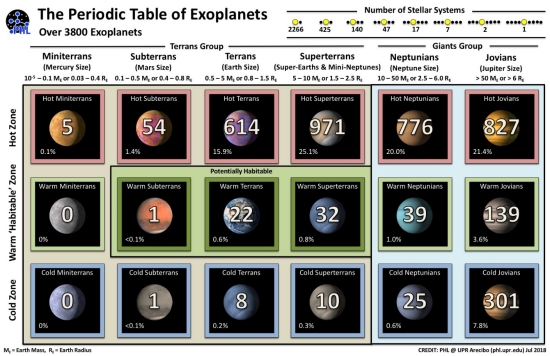
Figure 1. Confirmed exoplanets classified as a function of stellar proximity and mass as of July 2, 2018. RE = Earth radii, ME = Earth masses. (Credit: Abel Mendez, PHL @UPR Arecibo).
The Effect of the Moon in Stabilizing Earth’s Obliquity
The importance of the Moon in maintaining the habitability of Earth was a key issue raised in Rare Earth. Earlier modeling simulations [9] predicted that Earth would have exhibited much larger obliquity swings (from 0 to ~85°) than it does today (~22.1 to 24.5°) in the absence of a large Moon and assuming a present day orbital spin rate. As we know, a non-zero obliquity is necessary for the existence of seasons. At an obliquity (tilt) of zero degrees, our planet would cease to have them. Nevertheless, the relatively small ~2 degree change in tilt occurs over a period of about 41,000 years, in accordance with the predicted Milankovitch Cycles.
According to Ward and Brownlee, without the stabilizing presence of the Moon, the resultant obliquity cycles and climate variations would be so drastic that conditions would prohibit the emergence of complex life. This argument is likely still valid because even though more complex models find slightly smaller obliquity variations than originally predicted [9] (~50 degrees [10]), the resultant temperature variations are still large enough to be catastrophic for the survival of complex life.
One way to diminish these tilt-dependent temperature variations is by greatly increasing the atmospheric pressure, which enhances the transport of heat and moisture across the planet. Although this may be accomplished by having a multi-bar CO2 atmosphere [11], such a dense CO2 atmosphere is likely unbreathable by animals or other complex life, at least as-we-know-it to exist on our planet [12].
Another way to minimize climatic variations on a Moon-less Earth is by reducing its spin rate [11]. This can be achieved if, for example, the impactor event that led to the formation of the Moon never happened. However, the problem here is that much of the water delivered to the Earth was brought in during the late stages of accretion, possibly by the Moon-forming impact [13]. Thus, without that catastrophic event, Earth may have been a much drier, possibly lifeless, planet, one without plate tectonics (more on this next).
The Importance and Uniqueness of Plate Tectonics
Ward and Brownlee argue that plate tectonics is rare because it would require a serendipitous Moon-forming impact. In their book, they stress that plate tectonics is key to continental formation, which potentially promotes biodiversity and are key habitats for animal (complex) life. It is also thought that liquid water is necessary for the initiation of plate tectonics, for at least two reasons. First, water lubricates the plates, which permits sliding motions. Secondly, water cools the seafloor as it spreads, which helps maintain plate rigidity.
If the Moon-forming impact (among any other late impactors) was what delivered much of our planet’s water, then Ward and Brownlee could be right about what initiated plate tectonics. However, we still do not know when plate tectonics on our planet actually started. If plate tectonics was triggered by ample water delivery, then we would expect plate tectonics to have initiated early on, possibly soon after the Earth’s surface became habitable and capable of supporting liquid water ~4.3 – 4.4 Gyr [14]. The problem is that a wide range of start dates for plate tectonics has been proposed, between ~4.2 – 0.85 Gyr ago [15]. Thus, if plate tectonics started later, the implication is that water may only be a necessary – but insufficient – condition for plate tectonics.
In recent years, there has been a debate over whether plate tectonics is possible on terrestrial planets that are larger than Earth. One school of thought says that increased gravitational resistance on super-Earths reduces subduction tendency, dampening the potential for plate tectonics [16,17]. However, others argue that increased shear stresses help overcome resistance to plate motions [18]. Clearly, how interior processes scale to more massive planets is poorly understood.
The Difference Between the Habitable Zone and the Complex Life Habitable Zone
Ward and Brownlee define the “animal habitable zone” (AHZ) as the region around a star where a planet could support a mean surface temperature between 0 and 50 degrees Celsius. They correctly argue that that the AHZ should be significantly narrower than the classical habitable zone (HZ) (~0.95 – 1.67 AU) originally formulated by Kasting et al. [19]. This is because the classical HZ posits that multi-bar CO2 atmospheres could exist near the outer edge, which would be deleterious to life as-we-know-it on Earth. Thus, this classical HZ definition should not be used to search for complex life.
Recent studies have shown that a HZ for complex life would be approximately half as wide as the classical HZ [12, 20]. However, such work shows that a complex life habitable zone (CLHZ) is not just dependent on temperature ranges, but on respiration limits determined by the atmospheric composition and pressure. The Meyer-Overton correlation [21], which relates respiration to the solubility of gases in lipids, was used to show that many land animals on Earth could acclimate to breathing in air with CO2 and N2 pressures no higher than ~0.1 bar and 2 bar, respectively [12]. Experimental data also support these theoretical predictions [12]. Above such limits, narcotic effects, similar to intoxication, could become potentially lethal. I have used these theoretical and experimental results to compute a solar system CLHZ outer edge at ~1.31 AU [12] (Figure 2).
At the inner edge, 1-D models had predicted that a moist greenhouse is triggered above a mean surface temperature of ~340 K, leading to atmospheric escape rates to space that can deplete an Earth-like surface water inventory within in ~4.5 Gyr (the age of the solar system). Other more advanced models find that a full runaway greenhouse is triggered at lower mean surface temperatures (~330 K) before a moist runaway greenhouse can even occur [22, 23]. Nevertheless, the CLHZ width for our solar system is approximately half that of the classical HZ, assuming alien life would exhibit similar respiratory limits as does life on Earth. This latter assumption may or may not be the case, however, and future experiments and studies would need to shed light on this question.
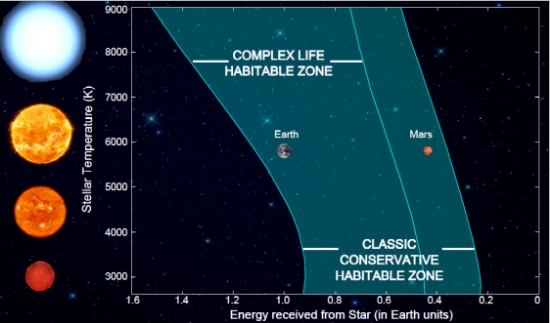
Figure 2. The complex life habitable zone [12], most applicable to animal life, is significantly narrower than the classical habitable zone [19]. Adapted from work in ref:12.
The Pre-Main-Sequence Habitable Zone
The temporal evolution of the HZ is central to our ability to find potentially habitable exoplanets for follow-up atmospheric characterization. Although the classical HZ is concerned with the main-sequence evolution of the host star, it is the pre-main-sequence evolution that largely determines whether a planet can acquire and retain volatiles, especially those orbiting M-dwarf stars [24-26]. This impacts the likelihood that a planet that is later located in the main-sequence HZ is habitable or not.
The reason for this is straightforward. At the beginning of the pre-main-sequence stage, a young star is at its brightest and becomes dimmer as it slowly contracts until it achieves gravitational equilibrium at the start of the main-sequence phase. Unlike other stars, which are only slightly brighter during the pre-main-sequence phase, M-stars can be orders of magnitude brighter during their pre-main-sequence phase as compared to when they appear on the main-sequence (Figure 3). As a result, this pre-main-sequence HZ is much farther out during this time, sweeping inward as the star dims. During this stage of stellar contraction, conditions within the inner stellar system are very hot and runaway greenhouse conditions are triggered, possibly desiccating any planets before the star reaches the main sequence.
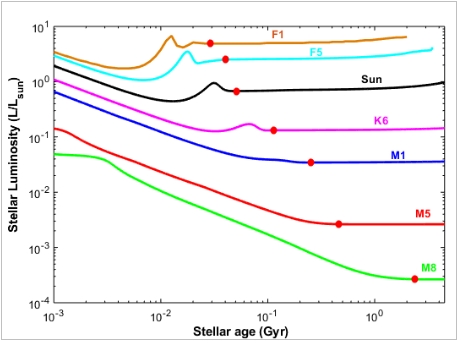
Figure 3. Pre-main-sequence stellar luminosity starts high and decreases with time until the start of the main-sequence (red point). Figure reproduced from ref:58 and based on work from ref: 25.
Binary Star Systems do have Planets
Ward and Brownlee had argued that binary star systems, which comprise about half of all stellar systems [27], may not have planets. Indeed, when Rare Earth was written, planets had not been detected around binary systems. Since then, however, we have certainly detected many such systems [28]. At this point, the debate is no longer whether such planets exist (they do), but whether they can be habitable. Some of these planets have been found in the HZ of their stars [29], which suggests the potential to host life. However, the fluxes that planets in these systems receive can vary wildly throughout the orbital cycle, impacting their habitability. Some may be repeatedly entering and exiting their stars’ HZ. Dynamic effects also impact the orbital stability of these multiple star systems.
The Galactic Habitable Zone
The galactic habitable zone (GHZ) is the galactic equivalent of the traditional stellar HZ and is the region within the Milky Way where liquid water could be stable on a planetary surface and animal life can be supported [30]. Subsequent work further quantified the GHZ based on stellar age, metallicity, and galocentric distance [31] (Figure 4). For instance, too close to the galactic center, and deadly supernovae and gamma ray bursts are much more abundant. Likewise, if the star is either too far away or too old, the system is unlikely to possess the heavier elements that are necessary to produce rocky planets.
Ward and Brownlee had applied the GHZ to argue that our solar system happens to be located in a very special region where these factors are just right for animals and beings like us to emerge. Even if this was true, however, one should note that our Milky Way galaxy spans ~100,000 light years and contains a few hundred billion stars. This would still mean that there are many millions of stars located within just a few hundred light years from our Sun, providing ample opportunity for life, even complex life, to be found within our solar neighborhood. Moreover, recent telescopes, like Kepler, are designed to observe planets that are no more than a couple thousand light years from our solar system, which would be well within GHZ regions that are most favorable to life.
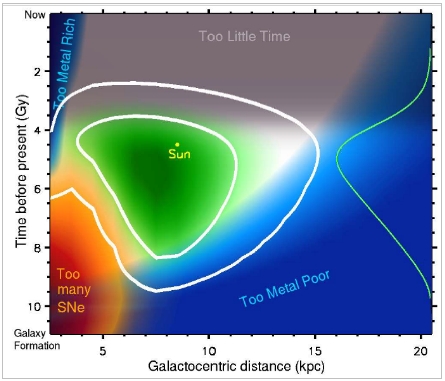
Figure 4: The galactic habitable zone [30]. Our Sun is located within the galactic region that is most suitable for life. Figure reproduced from ref: 31.
The “Anomalously” High Metallicity and Lower Activity Level of Our Sun
Ward and Brownlee cite Gonzalez [32], who indicated that our Sun is more metal-rich than the average star, including those of its same spectral type (G-star). On this basis, it was concluded that our Sun has an anomalously high metallicity. However, there is some confusion on this topic because Gonzalez [32] did not actually measure the metallicity per se, but the ratio of iron to hydrogen. To further confuse a planetary scientist (like myself), astronomers tend to refer to all elements heavier than H or He as “metals”. This Fe/H ratio is often taken as a proxy for metallicity. Nevertheless, Gonzalez [32] found that ~10% of the stars had an even higher Fe/H, suggesting an above average, but not anomalously high metallicity for our Sun.
However, subsequent studies have done more extensive stellar mineralogy that go well beyond the Fe/H story. These investigations find that refractory element (non-volatile) abundances are somewhat higher whereas those for volatiles are somewhat lower for solar analogues than for the Sun [33]. The cause for this pattern is unclear, but it may be attributed either to loss of disc material during planet formation or ingestion of planetary material by the host stars themselves [34-36]. More recent work has found that stellar magnetic activity and galactic chemical evolution can also affect measured stellar abundances, making diagnostic determinations difficult [37,38].
Overall, the inferred mineralogic trends and associated mechanisms to explain them continue to be a subject of debate. However, there is no a priori reason to assume that our Sun is a unique outlier in this regard. We even have two neighboring stars – Alpha Centauri A and B – that are quite similar to our Sun in many respects. Indeed, the mean surface temperature of Alpha Centauri A is almost identical to that of our Sun and Fe/H is somewhat higher [39].
Even though solar metallicity may not be that unusual, the Sun exhibits lower levels of stellar activity than those measured for nearly any other Sun-like star [40]. This could suggest that our Sun is a rare star. Alternatively, perhaps the Sun is in a temporary state of low activity and will become much more active in the future. If so, then complex life is only possible during a very narrow window of time in a Sun-like star’s history.
Most Stars don’t have Planets
Ward and Brownlee argued that only 5 – 6% of detected stars have planets, and that most of these are hot Jupiters, which are uninhabitable. Of course, planetary data were relatively scarce when this inference was made. Thanks to the Kepler mission, however, we now believe that nearly all stars have planets [41]. What’s more is that a wide variety of planet types, including Earths, super-Earths, mini-Neptunes, Neptunes, and Jupiters (both hot and cold), populate the cosmos. Indeed, the earlier reported high frequency of hot Jupiters can now be attributed to observational biases in the transit and radial velocity methods, techniques that are particularly sensitive to larger planets traveling in smaller orbits. What’s more is that two classes of relatively common exoplanets, super-Earths and mini-Neptunes, have no equivalents in our solar system. We live in exciting times. Indeed, the apparent ubiquity of exoplanets is an argument some use to suggest that our Earth may not be so rare after all.
It even seems quite common to find terrestrial planets located within their star’s HZ. Recent work has estimated ?earth, which is the fraction of stars that host at least one terrestrial planet within their star’s HZ. This ?earth value is important because missions use it to estimate the number of habitable zone planets that can be detected by upcoming missions, directly influencing the size of the telescope that is eventually designed. This ?earth value was found to be between ~15 – 45% for M-stars [42]. Extended to F-K stars, ?earth approaches 9% [43], assuming a conservative definition of the classical CO2-H2O HZ [44]. Other studies over the years have found similar results. The point here is that rocky planets are common, including those located within the HZ. That said, ?earth has not been estimated for the CLHZ [12], which is more appropriate for animal life. However, given that the CLHZ is approximately half as wide as the classical HZ, the above numbers would probably not drop by much more than a factor of 2, suggesting a CLHZ ?earth approaching 5 – 10% or so.
Massive Stars cannot evolve complex life
Main-sequence stars that are heavier than our Sun are hotter and burn their stellar fuel (converting hydrogen to helium) more quickly. This is why massive stars have shorter lifetimes. Rare Earth then suggests that the main-sequence lifetimes of stars with masses exceeding ~1.5 times that of our Sun (~ a F5) are too short for animals to evolve. This comes from assuming that it would take an Earth-like 3.5 – 4 Gyr for animals to emerge on potentially habitable exoplanets. However, there is no a priori reason to believe that complex life elsewhere would take the same amount of time to arise that it took here. I think it is more reasonable to expect that animals can arise either more slowly or quickly on other planets, depending on the specific circumstances.
The authors further argue that the high UV radiation on planets orbiting more massive stars could be harmful to surface life. We know this from everyday experience, which is why we should wear sunblock on particularly sunny days. However, enhanced UV radiation from massive stars is offset by ozone absorption in an oxygen-rich atmosphere [45]. Moreover, UV-C radiation (between 100 and 280 nm) may actually be beneficial to prebiotic chemistry [46].
Ward and Brownlee also argue that UV fluxes would be high enough from massive stars to drive atmospheric escape (EUV and XUV fluxes are energetic enough). Although such fluxes may be 2 or 3 times higher for massive stars than they are for the Sun [47], HZ planets orbiting these brighter stars are also on longer orbits, which is partially offsetting because stellar radiation decreases rapidly with distance.
Earth has Just the Right Amount of Water
Another argument made in Rare Earth is that Earth has just the right amount of water present on its surface. Too much, and there are no continents. Too little, and it may not be enough for life to exist. As Ward and Brownlee point out, water-rich impactors (e.g. carbonaceous meteorites) would have supplied the young forming Earth. During this late stage of accretion, a steam atmosphere would have likely arrived in an unsteady equilibrium with the water dissolved within the hot silicate melt that characterizes the surface and much of the interior.
There has been significant progress on this topic within the last several years. In the case of some M-stars, the interior may need to exceed ~5% wt. H2 to produce a steam atmosphere at all [48]. This problem is further compounded by early atmospheric escape processes associated with high stellar radiation fluxes. Thus, whether a planet can eventually retain any surface water at all depends on a complex interplay between these competing escape and delivery processes.
Furthermore, decay of radioactive isotopes, like Al-26, within the interior can also desiccate planets [49]. The half-life of Al-26 is very short (only about 700,000 years) so this mechanism can potentially desiccate small planets with very short formation timescales, like (possibly) a young Mars [50]. Radiogenic heating can also desiccate very young planetesimals in the early stages of accretion before they combine to form planets [49].
However, Earth took a long time to form, approximately ~50 million years. If Earth had acquired most of its water during the late stages of accretion, possibly in the Moon-forming impact [13], among any others, early desiccation via radioactive decay of Al-26 would not have occurred. Thus, given all of the various ways that things could go wrong during water delivery, the possibility that Earth might be rare in this aspect deserves further attention.
Earth has just the right amount of Carbon Dioxide
The authors assert that if Earth had more CO2, it could have ended up as hot as Venus (~ 735 K mean surface temperature). However, this exact scenario has been assessed by myself and others and we find that predicted mean surface temperatures are not much higher than ~500 K, even if 100 bars of CO2 were abruptly added to the atmosphere [51,52]. This is because the atmospheric water vapor pressure is outstripped by that of CO2. The lower atmospheric water vapor concentration then produces a weakened overall CO2-H2O greenhouse effect. Nevertheless, such temperatures are still much too high for the existence of life as-we-know-it, being more than 100 K hotter than what is needed to break atomic bonds [53]. Again, such CO2 pressures are also much too high for complex life, which requires significantly lower CO2 pressures [12].
In a more realistic case, CO2 levels would increase slowly and modestly above current CO2 levels. In that scenario, some of that atmospheric CO2 would be slowly drawn down through precipitation and silicate weathering, in a process called the carbonate-silicate cycle, which operates over million-year time scales. Over these relatively long timescales, Earth would likely re-equilibrate to a slightly higher temperature to compensate for the gradually brightening Sun. In any case, CO2 levels would be low enough to support complex life.
The Importance of Earth’s Magnetic Field
As Ward and Brownlee noted, various indicators suggest that Earth’s magnetic field contributed to its habitability. Earth’s magnetic field ensures that harmful solar particles don’t gradually erode the atmosphere. To make some sense of this, it is worth looking at the other classical HZ planet in our solar system, Mars. Although the Red Planet does not possess an intrinsic magnetic field today, it did have one at least 3.5 Gyr ago, which would have granted some protection to its early atmosphere, possibly keeping it thick long enough to help explain the geologic evidence indicating a once warmer and wetter planet. Unfortunately, Mars was too small to retain its interior heat for as long as Earth has, which led to a shutdown in its magnetic field. This would have rendered its atmosphere exceedingly vulnerable to sputtering and other loss processes, as MAVEN has shown are still occurring today [54].
It is also helpful to evaluate the other two terrestrial planets. Although Mercury does not possess an atmosphere, it does have a magnetic field, albeit weaker than Earth’s. One may use this to argue against the importance of a magnetic field except that Mercury is located too close to the Sun and far away from the HZ. Therefore, the planet would have been unable to sustain water on its surface with or without a magnetic field.
Likewise, one may be tempted to argue that Venus is able to retain a thick atmosphere without a magnetic field. On face value, this argument may make sense but there are a couple of key caveats. First, like Mercury, Venus is not located in the HZ, and its close proximity to the star ensures that water cannot be supported on its surface today. Secondly, its thick atmosphere likely results from a cessation in plate tectonics, possibly caused by an early runaway greenhouse that desiccated the planet [55]. This would have shut down atmospheric CO2 removal processes (like rainfall), resulting in unmitigated volcanism and an excessive buildup of atmospheric CO2. Such dense CO2 atmospheres exhibit high cooling rates, making them far less susceptible to losses from solar wind stripping. This is how a planet with no magnetic field, like Venus, can still retain a thick atmosphere. However, such a planet is clearly not habitable, so this is a moot point. Magnetic fields do not necessarily make planets habitable, but they can sustain habitable conditions on planets that already are. For the two known cases of terrestrial HZ planets, one has a thick magnetic field (Earth) whereas the other doesn’t (Mars). So, Ward and Brownlee may be on the right track by suggesting that potent magnetic fields may be common among habitable planets capable of producing complex life (Figure 5).
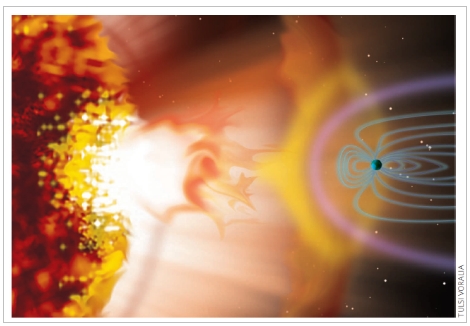
Figure 5: Strong magnetic fields appear to help maintain the habitability of habitable planets Figure reproduced from ref: 59. Image Credit: Tulsa Voralia
The Cambrian Explosion Was Triggered by a Special Event
We still do not know what triggered the Cambrian explosion on our planet nor how it happened. This “explosion” refers to the sudden appearance of most of the major body plans for complex lifeforms, in an event that occurred at the beginning of the Cambrian period (~540 million years ago). Ward and Brownlee note 4 proposed hypotheses: 1) a rise in atmospheric O2; 2) increased availability of nutrients; 3) an increase in global temperatures following a global snowball event; or 4) rapid true polar wander and continental reconfiguration. However, in isolation, each of these explanations is problematic. For instance, the rise in O2 occurred some 50 Myr or more before the Cambrian explosion, suggesting the former may not have been the immediate trigger for the latter. Also, molecular evidence indicates that simple metazoans may have existed more than a hundred million years before the major rise of O2 [56]. An increase in global temperatures also cannot explain why this increase in biodiversity had not occurred when temperatures were presumably higher in other times during Earth’s past. As mentioned earlier, atmospheric CO2 levels exceeding ~0.1 bar CO2 (~250 times PAL) may be deleterious to complex life as we know it on Earth. So, it would not matter much if rapid true polar wander occurred while CO2 levels remained too high for the emergence of complex life. Indeed, CO2 levels were gradually decreasing throughout Earth’s geologic history [57], decreasing below ~0.01 bar by the Cambrian explosion. Altogether, it is probable that there was not one single trigger, but a series of overlapping conditions that had to be met before complex life finally arose. Such a special scenario could be seen as supporting Ward and Brownlee’s core argument.
Conclusions
An impartial evaluation of the evidence supports the premise that complex life, including animal life, might be rare throughout the cosmos. At the same time, there remains sufficient uncertainty to question that conclusion. The Fermi Paradox, which attempts to explain the apparent contradiction between the perceived high probability of extraterrestrial intelligence with the lack of actual contact, still cannot be answered at this time. If the Rare Earth hypothesis is correct, a SETI search for complex (i.e., intelligent) life faces unbelievably low chances of success.
On the other hand, if animal and (ultimately) intelligent alien life are relatively common, we could obtain positive proof of their existence within the next few decades. As exciting as this latter prospect is, it could also be rather frightening. After all, some of these civilizations may be more advanced than we are, requiring the formulation of careful protocols to ensure safe contact. However, if intelligent life elsewhere really is common, we have to ask why nobody has visited us yet. This scenario could suggest that the technology to visit such alien systems is extremely difficult to develop, if not impossible, unless we are among the most advanced civilizations in the universe.
Nevertheless, we wish to maximize our chances of finding life elsewhere by assuming that E.T. is rare and difficult to find. Under that assumption, we will not find complex life on other planets with our current technology. This news should not discourage us, but instead embolden our leaders to invest more heavily in space science and engineering. Such initiatives would help produce improved telescopes and techniques that would enable us to search for extraterrestrial intelligence and have a reasonable chance of finding it.
References
1) Wetherill, G.W., 1994. Possible Consequences of Absence of “Jupiters “in Planetary Systems. In Planetary Systems: Formation, Evolution, and Detection (pp. 23-32). Springer, Dordrecht.
2) Wright, J.T., Marcy, G.W., Howard, A.W., Johnson, J.A., Morton, T.D. and Fischer, D.A., 2012. The frequency of hot Jupiters orbiting nearby solar-type stars. The Astrophysical Journal, 753(2), p.160.
3) Hansen, B.M., 2015. In situ models for planet assembly around cool stars. International Journal of Astrobiology, 14(2), pp.267-278.
4) Lissauer, J.J., 2007. Planets formed in habitable zones of M dwarf stars probably are deficient in volatiles. The Astrophysical Journal Letters, 660(2), p.L149.
5) Raymond, S.N., Scalo, J. and Meadows, V.S., 2007. A decreased probability of habitable planet formation around low-mass stars. The Astrophysical Journal, 669(1), p.606.
6) Alibert, Y. and Benz, W., 2017. Formation and composition of planets around very low mass stars. Astronomy & Astrophysics, 598, p.L5.
7) Kite, E.S., Manga, M. and Gaidos, E., 2009. Geodynamics and rate of volcanism on massive Earth-like planets. The Astrophysical Journal, 700(2), p.1732.
8) Ramirez, R.M. and Levi, A., 2018. The ice cap zone: a unique habitable zone for ocean worlds. Monthly Notices of the Royal Astronomical Society, 477(4), pp.4627-4640.
9) Laskar, J., Correia, A.C.M., Gastineau, M., Joutel, F., Levrard, B. and Robutel, P., 2004. Long term evolution and chaotic diffusion of the insolation quantities of Mars. Icarus, 170(2), pp.343-364.
10) Lissauer, J.J., Barnes, J.W. and Chambers, J.E., 2012. Obliquity variations of a moonless Earth. Icarus, 217(1), pp.77-87.
11) Williams, D.M. and Kasting, J.F., 1997. Habitable planets with high obliquities. Icarus, 129(1), pp.254-267.
12) Ramirez, R.M., 2020. A Complex Life Habitable Zone Based On Lipid Solubility Theory. Scientific Reports, 10(1), pp.1-8.
13) Budde, G., Burkhardt, C. and Kleine, T., 2019. Molybdenum isotopic evidence for the late accretion of outer Solar System material to Earth. Nature Astronomy, 3(8), pp.736-741.
14) Valley, J.W., Peck, W.H., King, E.M. and Wilde, S.A., 2002. A cool early Earth. Geology, 30(4), pp.351-354.
15) Korenaga, J., 2013. Initiation and evolution of plate tectonics on Earth: theories and observations. Annual review of earth and planetary sciences, 41, pp.117-151.
16) Noack, L. and Breuer, D., 2014. Plate tectonics on rocky exoplanets: influence of initial conditions and mantle rheology. Planetary and Space Science, 98, pp.41-49.
17) O’Neill, C. and Lenardic, A., 2007. Geological consequences of super?sized Earths. Geophysical Research Letters, 34(19).
18) Valencia, D., O’connell, R.J. and Sasselov, D.D., 2007. Inevitability of plate tectonics on super-Earths. The Astrophysical Journal Letters, 670(1), p.L45.
19) Kasting, J.F., Whitmire, D.P. and Reynolds, R.T., 1993. Habitable zones around main sequence stars. Icarus, 101(1), pp.108-128.
20) Schwieterman, E.W., Reinhard, C.T., Olson, S.L., Harman, C.E. and Lyons, T.W., 2019. A limited habitable zone for complex life. The Astrophysical Journal, 878(1), p.19.
21) Bennett, P.B. and Rostain, J.C., 1993. Inert gas narcosis. The Physiology and Medicine of Diving. Edited by Bennett PB, Elliot DH. London, Saunders, pp.171-93.
22) Leconte, J., Forget, F., Charnay, B., Wordsworth, R. and Pottier, A., 2013. Increased insolation threshold for runaway greenhouse processes on Earth-like planets. Nature, 504(7479), pp.268-271.
23) Ramirez, R.M., 2020. The effect of high nitrogen pressures on the habitable zone and an appraisal of greenhouse states. Monthly Notices of the Royal Astronomical Society, 494(1), pp.259-270.
24) Luger, R. and Barnes, R., 2015. Extreme water loss and abiotic O2 buildup on planets throughout the habitable zones of M dwarfs. Astrobiology, 15(2), pp.119-143.
25) Ramirez, R.M. and Kaltenegger, L., 2014. The habitable zones of pre-main-sequence stars. The Astrophysical Journal Letters, 797(2), p.L25.
26) Tian, F. and Ida, S., 2015. Water contents of Earth-mass planets around M dwarfs. Nature Geoscience, 8(3), pp.177-180.
27) Raghavan, D., McAlister, H.A., Henry, T.J., Latham, D.W., Marcy, G.W., Mason, B.D., Gies, D.R., White, R.J. and Theo, A., 2010. A survey of stellar families: multiplicity of solar-type stars. The Astrophysical Journal Supplement Series, 190(1), p.1.
28) Armstrong, D.J., Osborn, H.P., Brown, D.J.A., Faedi, F., Gómez Maqueo Chew, Y., Martin, D.V., Pollacco, D. and Udry, S., 2014. On the abundance of circumbinary planets. Monthly Notices of the Royal Astronomical Society, 444(2), pp.1873-1883.
29) Eggl, S., Pilat-Lohinger, E., Funk, B., Georgakarakos, N. and Haghighipour, N., 2013. Circumstellar habitable zones of binary-star systems in the solar neighbourhood. Monthly Notices of the Royal Astronomical Society, 428(4), pp.3104-3113.
30) Gonzalez, G., Brownlee, D. and Ward, P., 2001. The galactic habitable zone: galactic chemical evolution. Icarus, 152(1), pp.185-200.
31) Lineweaver, C.H., Fenner, Y. and Gibson, B.K., 2004. The galactic habitable zone and the age distribution of complex life in the Milky Way. Science, 303(5654), pp.59-62.
32) Gonzalez, G., 1999. Are stars with planets anomalous?. Monthly Notices of the Royal Astronomical Society, 308(2), pp.447-458.
33) Ramírez, I., Melendez, J. and Asplund, M., 2009. Accurate abundance patterns of solar twins and analogs-Does the anomalous solar chemical composition come from planet formation?. Astronomy & Astrophysics, 508(1), pp.L17-L20.
34) Gonzalez, G., 1997. The stellar metallicity—giant planet connection. Monthly Notices of the Royal Astronomical Society, 285(2), pp.403-412.
35) Chambers, J.E., 2010. Stellar elemental abundance patterns: Implications for planet formation. The Astrophysical Journal, 724(1), p.92.
36) Bedell, M., Bean, J.L., Meléndez, J., Spina, L., Ramírez, I., Asplund, M., Alves-Brito, A., Dos Santos, L., Dreizler, S., Yong, D. and Monroe, T., 2018. The chemical homogeneity of sun-like stars in the solar neighborhood. The Astrophysical Journal, 865(1), p.68.
37) Schuler, S.C., Flateau, D., Cunha, K., King, J.R., Ghezzi, L. and Smith, V.V., 2011. Abundances of Stars with Planets: Trends with Condensation Temperature. The Astrophysical Journal, 732(1), p.55.
38) Spina, L., Nordlander, T., Casey, A.R., Bedell, M., D’Orazi, V., Meléndez, J., Karakas, A.I., Desidera, S., Baratella, M., Galarza, J.J.Y. and Casali, G., 2020. How magnetic activity alters what we learn from stellar spectra. The Astrophysical Journal, 895(1), p.52.
39) Thévenin, F., Provost, J., Morel, P., Berthomieu, G., Bouchy, F. and Carrier, F., 2002. Asteroseismology and calibration of ? Cen binary system. Astronomy & Astrophysics, 392(1), pp.L9-L12.
40) Reinhold, T., Shapiro, A.I., Solanki, S.K., Montet, B.T., Krivova, N.A., Cameron, R.H. and Amazo-Gómez, E.M., 2020. The Sun is less active than other solar-like stars. Science, 368(6490), pp.518-521.
41) Tuomi, M., Jones, H.R., Barnes, J.R., Anglada-Escudé, G. and Jenkins, J.S., 2014. Bayesian search for low-mass planets around nearby M dwarfs–estimates for occurrence rate based on global detectability statistics. Monthly Notices of the Royal Astronomical Society, 441(2), pp.1545-1569.
42) Dressing, C.D. and Charbonneau, D., 2013. The occurrence rate of small planets around small stars. The Astrophysical Journal, 767(1), p.95.
43) Petigura, E.A., Howard, A.W. and Marcy, G.W., 2013. Prevalence of Earth-size planets orbiting Sun-like stars. Proceedings of the National Academy of Sciences, 110(48), pp.19273-19278.
44) Kopparapu, R.K., Ramirez, R., Kasting, J.F., Eymet, V., Robinson, T.D., Mahadevan, S., Terrien, R.C., Domagal-Goldman, S., Meadows, V. and Deshpande, R., 2013. Habitable zones around main-sequence stars: new estimates. The Astrophysical Journal, 765(2), p.131.
45) Segura, A., Krelove, K., Kasting, J.F., Sommerlatt, D., Meadows, V., Crisp, D., Cohen, M. and Mlawer, E., 2003. Ozone concentrations and ultraviolet fluxes on Earth-like planets around other stars. Astrobiology, 3(4), pp.689-708.
46) Rimmer, P.B., Xu, J., Thompson, S.J., Gillen, E., Sutherland, J.D. and Queloz, D., 2018. The origin of RNA precursors on exoplanets. Science advances, 4(8), p.eaar3302.
47) Fossati, L., Koskinen, T., Lothringer, J.D., France, K., Young, M.E. and Sreejith, A.G., 2018. Extreme-ultraviolet Radiation from A-stars: Implications for Ultra-hot Jupiters. The Astrophysical Journal Letters, 868(2), p.L30.
48) Schaefer, L., Wordsworth, R.D., Berta-Thompson, Z. and Sasselov, D., 2016. Predictions of the atmospheric composition of GJ 1132b. The Astrophysical Journal, 829(2), p.63.
49) Lichtenberg, T., Golabek, G.J., Burn, R., Meyer, M.R., Alibert, Y., Gerya, T.V. and Mordasini, C., 2019. A water budget dichotomy of rocky protoplanets from 26 Al-heating. Nature Astronomy, 3(4), pp.307-313.
50) Dauphas, N. and Pourmand, A., 2011. Hf–W–Th evidence for rapid growth of Mars and its status as a planetary embryo. Nature, 473(7348), pp.489-492.
51) Kasting, J.F. and Ackerman, T.P., 1986. Climatic consequences of very high carbon dioxide levels in the Earth’s early atmosphere. Science, 234(4782), pp.1383-1385.
52) Ramirez, R.M., Kopparapu, R.K., Lindner, V. and Kasting, J.F., 2014. Can increased atmospheric CO2 levels trigger a runaway greenhouse?. Astrobiology, 14(8), pp.714-731.
53) Clarke, A., 2004. Is there a universal temperature dependence of metabolism?. Functional Ecology, 18(2), pp.252-256.
54) Jakosky, B.M., Brain, D., Chaffin, M., Curry, S., Deighan, J., Grebowsky, J., Halekas, J., Leblanc, F., Lillis, R., Luhmann, J.G. and Andersson, L., 2018. Loss of the Martian atmosphere to space: Present-day loss rates determined from MAVEN observations and integrated loss through time. Icarus, 315, pp.146-157.
55) Hamano, K., Abe, Y. and Genda, H., 2013. Emergence of two types of terrestrial planet on solidification of magma ocean. Nature, 497(7451), pp.607-610.
56) Wray, G.A., Levinton, J.S. and Shapiro, L.H., 1996. Molecular evidence for deep Precambrian divergences among metazoan phyla. Science, 274(5287), pp.568-573.
57) Berner, R.A. and Kothavala, Z., 2001. GEOCARB III: a revised model of atmospheric CO2 over Phanerozoic time. American Journal of Science, 301(2), pp.182-204.
58) Ramirez, R.M., 2018. A more comprehensive habitable zone for finding life on other planets. Geosciences, 8(8), p.280.
59) Ramirez, R., 2016. Early Earth: Atmosphere’s solar shock. Nature Geoscience, 9(6), pp.413-414.

A Suggestive Model for Europa’s Ocean
What we learn about Europa may resonate with other moons in the Solar System, making the study of this ‘ocean world’ even more valuable as we look elsewhere among the gas giants. I notice this morning that a team of researchers from the Jet Propulsion Laboratory has presented results on Europa at the Goldschmidt conference, held virtually from the 21st to 26th of this month. The work models geochemical reservoirs within Europa, analyzing the composition and properties of the core, a layer of silicates, and the ocean itself.
In the absence of hard data, models will have to do, and here we learn that a plausible composition for the Europan ocean can be advanced, one that postulates the breakdown of water-bearing minerals and the release of the trapped water. Mohit Melwani Daswani is lead researcher:
“We find that different minerals lose water and volatiles at different depths and temperatures. We added up these volatiles that are estimated to have been lost from the interior, and found that they are consistent with the current ocean’s predicted mass, meaning that they are probably present in the ocean.”
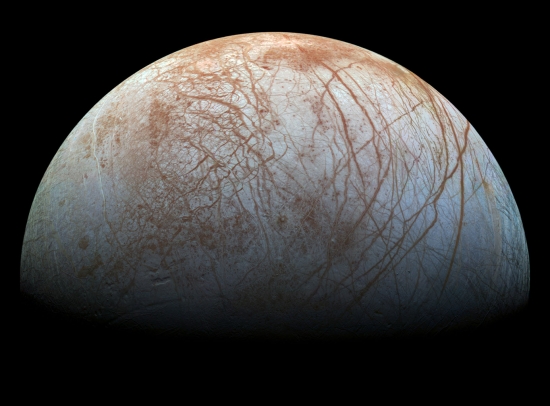
Image: The puzzling, fascinating surface of Jupiter’s icy moon Europa looms large in this newly-reprocessed color view, made from images taken by NASA’s Galileo spacecraft in the late 1990s. This is the color view of Europa from Galileo that shows the largest portion of the moon’s surface at the highest resolution. The view was previously released as a mosaic with lower resolution and strongly enhanced color. To create this new version, the images were assembled into a realistic color view of the surface that approximates how Europa would appear to the human eye. Credit: NASA/JPL-Caltech/SETI Institute.
Much depends upon internal sources of heat, and here we need data from future missions to the moon. According to the model, however, early radioactive decay or tidal movement below the surface could force the breakdown of water-containing minerals, releasing the water that formed the ocean. A mildly acidic ocean results from these calculations, highly concentrated in carbon dioxide, calcium and sulfate. The team used data from the Galileo mission as well as the Hubble instrument showing chloride on Europa’s surface, indicating that the water probably became chloride-rich. Says Daswani: “In other words, its composition became more like oceans on Earth. We believe that this ocean could be quite habitable for life.”
Geologist Steve Mojzsis (University of Colorado), not a part of the JPL team, sees the work in terms of chemical equilibrium, or more interestingly, the lack of it:
“A long-standing question over whether a ‘cloaked ocean’ world like Europa could be habitable boils down to whether it can sustain a flow of electrons which might provide the energy to power life. What remains unclear is whether such icy moons could ever generate enough heat to melt rock; certainly interesting chemistry takes place within these bodies, but what reliable flow of electrons could be used by alien life to power itself in the cold, dark depths? A key aspect that makes a world ‘habitable’ is an intrinsic ability to maintain these chemical disequilibria. Arguably, icy moons lack this ability, so this needs to be tested on any future mission to Europa.”
Europa Clipper is on the horizon, of course, and Daswani sees the current modeling as part of the scientific preparation for the mission. Noting the need to refine our ideas on the migration of fluids through Europa’s rocky interior, he adds that the current model of ocean formation could be readily extended to neighboring Ganymede, and even to Saturn’s large moon Titan. The JPL researchers are now collaborating with colleagues in Nantes and Prague to consider the possibility of seafloor volcanoes as contributing factors to Europa’s chloride-rich water.
Or is it actually chloride-rich? In 2019, Samantha Trumbo (Caltech) produced a paper with colleague Michael Brown and JPL’s Kevin Hand that studied the issue. How closely we can link the moon’s icy surface shell with the underlying ocean is an open question. Note this:
The presence of NaCl on Europa has important implications for our understanding of the internal chemistry and its geochemical evolution through time. Whereas aqueous differentiation of chondritic material and long-term leaching from a chondritic seafloor can result in a system rich in sulfates, more extensive hydrothermal circulation, as on Earth, may lead to an NaCl-rich ocean. The plume chemistry of Enceladus, which is perhaps the best analog to Europa, suggests an NaCl-dominated ocean and a hydrothermally active seafloor. However, the compositional relationship between Europa’s ocean and its endogenous material is unknown, and the surface may simply represent the end result of a compositional stratification within the ice shell… Regardless of whether the observed NaCl directly relates to the ocean composition, its presence warrants a reevaluation of our understanding of the geochemistry of Europa.
The Daswani paper is not yet available, so we’ll need to revisit this work in coming months. On the question of chloride on Europa’s surface, the paper is Trumbo et al., “Sodium Chloride on the Surface of Europa,” Science Advances Vol. 5, no. 6 (12 Jun 2019). Full text.

A Catalog of Celestial Exotica
Harmonizing with yesterday’s post about a NASA grant to study technosignatures is word from Breakthrough Listen, which has released a catalog of what it calls ‘exotica’ or, to cite the accompanying paper: “an 865 entry collection of 737 distinct targets intended to include “one of everything” in astronomy.” The idea is to produce a general reference work that can guide astronomical surveys and, in the case of Breakthrough, widen the search for technosignatures.
Brian Lacki (UC-Berkeley), who is lead author of the new catalog, notes that it’s not meant to be restricted to SETI, though its uses there may prove interesting. Here are the four categories of exotica the catalog defines:
- ‘Prototypes.’ Here the intent is to list one example, perhaps more, an archetype of every known type of non-transient object in the sky. According to the paper, “We emphasize the inclusion of many types of energetic and extreme objects like neutron stars…, but many quiescent examples are included too.”
- ‘Superlatives.’ These are objects with the most extreme properties (“among the most extreme in at least one major physical property, the record-breakers”), including unusually metallic stars, or the fastest known pulsar, the stars with the highest metal content and those with the lowest, etc. Here the list “includes objects of known subtypes but that are on the tail ends of the distribution of some properties, to better span the range of objects in the Universe.”
- ‘Anomalies.’ The enigmas go here, including objects like KIC 8462852 (Boyajian’s Star), whose odd lightcurve is still under examination and a long way from being explained, and ‘Oumuamua, the interstellar visitor that entered our system in 2017 and is now leaving it. We can also include phenomena that have triggered searches at both radio and optical frequencies — here I think of Fast Radio Bursts (FRBs), but stars with excess infrared radiation would also be on the list.
- A fourth category is a control sample of “sources not expected to produce positive results.”
So what to make of this? It’s apparently introduced as an attempt to jog our preconceptions, at least according to what Lacki says:
“Many discoveries in astronomy were not planned. Sometimes a major new discovery was missed when nobody was looking in the right place, because they believed nothing could be found there. This happened with exoplanets, which might have been detected before the 1990s if astronomers looked for solar systems very different than ours. Are we looking in the wrong places for technosignatures? The Exotica catalog will help us answer that question.”
Lacki’s point is well taken with regard to exoplanets. We quickly learned at the beginning of our exoplanet detections that stellar systems come in a huge variety of configurations, so that our own Solar System can hardly be considered a common template. Every new system studied now seems to drive this point home. As the paper notes, everything from the cosmic microwave background to gamma-ray bursts has been found by scientists who were not explicitly looking for what they discovered, usually because new instruments and telescopes widen our capabilities.
From the paper:
Other discoveries – like the moons of Mars or Cepheid variables in external galaxies – were delayed because no thorough observations were carried out on the targets (Hall 1878; Dick 2013). The pattern persists to this day. Because ultracompact dwarf galaxies have characteristics that fall in the cracks between other galaxies and globular clusters, they were only recognized recently despite being easily visible on images for decades (Sandoval et al. 2015). Of relevance to SETI, hot Jupiters were speculated about in the 1950s (Struve 1952), but they were not discovered until 1995 in part because no one systematically looked for them (for further context, see Mayor & Queloz 2012; Walker 2012; Cenadelli & Bernagozzi 2015). This may have delayed by years the understanding that exoplanets are not extremely rare, one of the factors in the widely-used Drake Equation in SETI relating the number of ETIs to evolutionary probabilities and their lifespan (Drake 1962).
Are there SETI discoveries that could be made if we widen the range of targets? Breakthrough Listen has already upped the pace of both radio and optical SETI, being a 10-year program whose core is a search for artificial radio emission from over 1,000 nearby stars, although a million more stars in the Milky Way are targeted for related study. The organization is clearly not averse to trying new approaches, hence its interest in technosignatures of the kind once suggested by Freeman Dyson, and its intention to expand the parameter space.
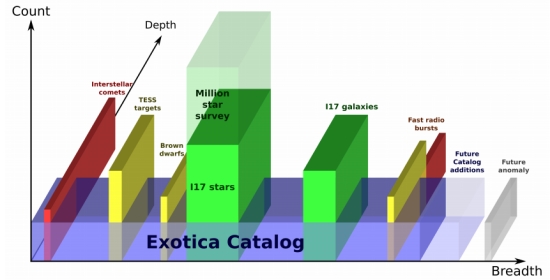
Image: This is Figure 1 from the paper. Caption: A cartoon of the three directions of target selection and the relative advantages of Breakthrough Listen’s primary programs observing stars and galaxies (green), a survey of the Breakthrough Listen Exotica Catalog (blue), and some example campaigns. Previous SETI surveys have generally aimed for depth, achieving strong limits for a small number of similar targets, or high-count, achieving modest limits for a large number of similar targets. Other exotica efforts can be high-depth (red) or high-count (gold) campaigns, but observations of the Exotica Catalog will be broad, achieving modest limits on a small number each of a wide variety of targets. Future discoveries may be added to a later version of the catalog (pale blue), or prompt new campaigns that we cannot yet plan for (grey). Credit: Lacki et al.
Andrew Siemion (UC-Berkeley), who leads the Breakthrough Listen science team, notes that the few searches for technosignatures that have taken place have largely focused on stars thought to host planets in their liquid water habitable zone (although exceptions like Penn State’s Glimpsing Heat from AlienTechnologies, working at the galactic scale, are clear exceptions to this). What Siemion wants to do is expand the search. ‘Survey breadth’ — how wide a range of objects is studied in an observing program — is the operative term.
Or we might ask, are there objects we now consider natural that may in fact be artificial? And which natural objects — perhaps Boyajian’s Star, for instance, or some FRBs — mimic the kind of artificial signal that SETI researchers are looking for? Breakthrough Listen will spend 10 percent of its observing time on exotic objects. The 737 objects in the Exotica Catalog are sorted into different levels of priority for observation, with about a dozen considered high priority for SETI. Most entries are considered low priority and slated for observation as time allows.
The paper continues:
There are many reasons to search for technological intelligence in unconventional places. Unearthlike or nonbiological entities will not be constrained to live in Earthly habitats hospitable to lifeforms like us. It is also conceivable that some kinds of seemingly natural phenomena are the result of alien engineering. Yet there are good motivations for observing unusual objects even if ETIs cannot possibly live there. Extreme, energetic objects are more likely to produce unusual signals, particularly transients, that might be confused with artificial signals. Breakthrough Listen has unique instrumentation, and observation of a broad range of objects would benefit the general astronomy community. Finally, there could be unaccounted for systematic errors in our systems that give false positives. Observing exotic objects and empty regions on the sky allow us to constrain these possibilities.
You can find the Breakthrough Listen Exotica Catalog here. The paper is Lacki et al., “One of Everything: The Breakthrough Listen Exotica Catalog,” available in draft version online.

Advancing the Search for Technosignatures
What a pleasure to see — after three decades — a grant from NASA for a SETI project, and on technosignatures at that. NASA’s history with SETI has been a challenging one given the subject’s reception in Congress. It was in 1971 that the agency funded Barney Oliver’s study on the huge array called Project Cyclops, whose price-tag would have been astronomical, but the report in which it was described provided numerous insights into the SETI effort. NASA’s engagement with SETI later came under fire from William Proxmire in the Senate, resulting in the termination of SETI funding in 1982. Proxmire would later change his mind on SETI’s value.
Even so, the NASA Microwave Observing Program (MOP) planned as a search of 800 nearby stars in the early 1990’s was again targeted in Congress and canceled shortly thereafter. The SETI effort developed in the ensuing years without government funding through efforts like Project Phoenix, which picked up the Mobile Observing Program under the guidance of Jill Tarter and the SETI Institute. With a number of interesting projects along the way, SETI has remained an ad hoc, privately funded effort in the US, with ongoing work through Breakthrough Listen, the Allen Telescope Array, the Berkeley SETI Research Center (SERENDIP) and others. The SETI League continues an energetic grassroots effort under the guidance of Paul Shuch. It’s interesting to note that in China, SETI is explicitly folded into the FAST radio observatory’s charter.
I haven’t gotten into optical SETI or other SETI projects in the US and abroad, but the point is that a new NASA grant makes a welcome return of NASA’s willingness to look at SETI, and with an eye toward the cutting-edge question of technosignatures as opposed to the reception of radio or optical signals. Here we’re talking about what might be created by advanced cultures, everything from vast Dyson spheres exploiting the host star’s energies to industrial pollution in exoplanet atmospheres, or even city lights. Exoplanet research motivates the current attention, says Adam Frank (University of Rochester), the primary recipient of the grant. Says Frank:
“The Search for Extraterrestrial Intelligence (SETI) has always faced the challenge of figuring out where to look. Which stars do you point your telescope at and look for signals? Now we know where to look. We have thousands of exoplanets including planets in the habitable zone where life can form. The game has changed.”
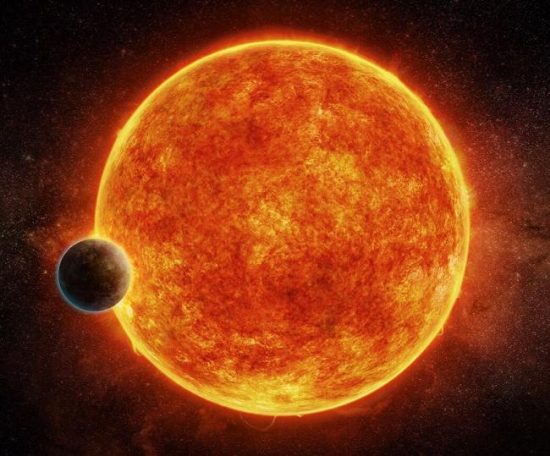
Image: Artist’s impression of the exoplanet LHS 1140b, which orbits its star within the “habitable zone” where liquid water might exist on the surface. The LHS 1140 system is only about 40 light-years from Earth, making it a possible target for studying the atmosphere of the planet if it has one. Credit: M. Weiss/CfA.
Called “Characterizing Atmospheric Technosignatures,” the new study will focus on solar panels and pollutants as indicators of technological activities. Avi Loeb (Harvard University) explains:
“The nearest star to Earth, Proxima Centauri, hosts a habitable planet, Proxima b. The planet is thought to be tidally locked with permanent day and night sides. If a civilization wants to illuminate or warm up the night side, they would place photovoltaic cells on the day side and transfer the electric power gained to the night side.”
What the study probes is how something like this would be detected if present, as a way of developing the mathematical and observational tools that can extend technosignature searches to various nearby stars. We are developing the ground- and space-based observatories with which this work can be conducted, but telescope time is precious, and knowing how and where to look is a critical issue. As we begin to be able to probe the atmospheres of rocky planets, we’ll have the potential for detecting not just biosignatures but evidence of artificially produced molecules that, like chlorofluorocarbons (CFCs), are unlikely to appear naturally.
Along with Harvard’s Loeb, Frank is joined in the effort by Penn State’s Jason Wright, Mansavi Lingam of the Florida Institute of Technology, and Jacob Haqq-Misra of Blue Marble Space. Out of the study, we can hope, will come quantitative information about how the project of technosignature detection can proceed. Let me recommend Frank’s The Light of the Stars (W. W. Norton & Company, 2018), along with Jason Wright’s Astrowright site for continuing insights into technosignatures. Also have a look at Wright’s Glimpsing Heat from Alien Technologies, published in these pages several years ago.

Planetary Days as a SETI Factor
Yesterday we looked at a new paper from Robert Gray on the possibility — even likelihood — that the kind of signal SETI is looking for would be intermittent in nature rather than continuous. The numbers tell the story: In Gray’s calculations, an isotropic transmission with a range of 1,000 light years — i.e., a continuous beacon broadcasting in all directions — requires on the order of 1015 W to produce the kind of signal-to-noise ratio that would allow us to pick it up with facilities like those used in current SETI searches.
1015 is a big number, going beyond the current terrestrial power consumption of 1013 W by orders of magnitude and reaching 1 percent of the total power received by Earth from the Sun. Reduce the desired range of the signal to 100 light years and the requirement for isotropic broadcasts is still daunting, demanding something like 1013 W, or 10,000 1,000 MW power plants. As Gray puts it:
The large power required for continuous isotropic broadcasts could conceivably be available to some very technologically advanced civilizations (Kardashev 1964, 1967), but assuming very advanced civilizations seems very optimistic.
Indeed. Hence the need to ponder alternatives. Consider the savings gained, for example, in using high-gain antenna systems to target single stars. Gray describes an Arecibo-class transmitting antenna following this strategy. Now the power requirement begins to fall to recognizable levels. An Arecibo-like transmitting antenna punching out a signal to a star 1,000 light years away needs 108 W, dropping to 106 W for a range of 100 light years. In other words, this we can do today with the actual Arecibo planetary radar.
Transmitting is one thing, reception quite another. If we think in terms of sending a signal to more than one target star, broadcasting to each in succession in a repetitive pattern, we are sending a signal that would obviously appear intermittent to any receiving station, and factors that are entirely unknown to us come into play. How often would such signals repeat? We would need to know the number of targets the transmitting civilization had chosen and the dwell time devoted to each. Any calculations we run fall victim to the depth of the imponderables here.
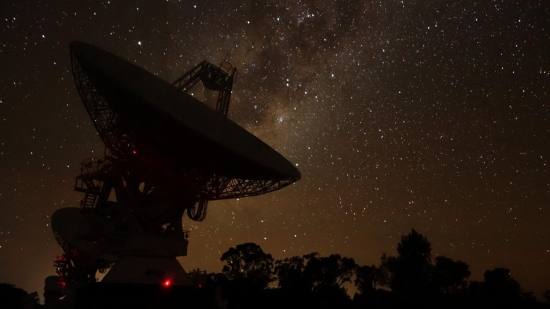
Image: Australia Telescope Compact Array (ATCA) antennas at night. Credit: Sascha Schediwy.
But there are a few numbers we might plug in to give us a sense of the possibilities. Gray’s paper looks at planetary rotation periods as an indicator. The thinking is that transmission from the surface of planets could make rotation a factor, rendering some signals periodic. In our own Solar System, we find a median day of 23.9 hours (dropping to 21.1 hours if we leave Pluto out). Three quarters of the eight planets have days in the range of 10-25 hours. Our knowledge of exoplanet days will grow with time, allowing us to get a sense of day length for the planets we are most interested in: Rocky planets in or near the habitable zone of stars other than our own.
Thus the ‘interstellar lighthouse,’ a directional transmission from a fixed antenna on a rotating planet producing an intermittent signal with the period of the planet’s sidereal day:
In the case of a source planet with the median day in our planetary system and a rotating 1° lune, distant observers would be illuminated for 23.9/360 = 0.0664 hours or 3.9 minutes every 23.9 hours. Such a signaling strategy would have the isotropic broadcasting advantage of illuminating the entire sky although not constantly, and the directional transmission advantage of much lower power requirements than isotropic, and with no need for tracking. A transmission from a rotating antenna system might display a signature Gaussian rise and fall as it swept across a detector, and that might suggest re-observation efforts scaled to a planetary day.
A daily cadence for both radio and optical SETI is thus a possibility, and as Gray notes, most of our searches (and transmissions) have been conducted from single sites on the surface. Planetary days would be a known factor in specifically targeted transmissions. Obviously, there are other options here, including using multiple scattered sites like the Deep Space Network on Earth, or operating a transmitter from space, so this is only one factor to consider.
A distant civilization detecting our transmissions would note the periodicity of the signal based on the terrestrial sidereal day, and conceivably might use the same timing to return a signal to us. Other time intervals studied in this paper include pulse periodicities — are there, in other words, preferred periodicities in signaling just as there may be preferred frequencies? 21 possible time intervals, some defined by pulsar periods, have been suggested in the literature. Orbital periods are an obvious interval for targeted signaling, while some recent papers have suggested synchronization between astronomical events like the conjunction of two exoplanets along the line of sight from Earth or the opposition of planets in other planetary systems.
Thus the assumption of continuous signals and very brief observation times becomes problematic if the signals we are looking for are intermittent. Historically, the longest observation of a single field is 100 hours in work at the Allen Telescope Array, although Gray also notes Frank Drake’s work at Project Ozma, which studied Tau Ceti and Epsilon Eridani for approximately 100 hours each. Intermittent signals would demand long dwell times, but a consideration of a planetary day time scale might prove a useful guide to operations.
A planetary day time scale might be useful in searching for interstellar signals, because planetary rotation would have physical effects on both transmissions and searches operating on the surface of planets. Observations over a planetary day would off course cover many possible shorter repetition rates; observations extending over approximately 25 hours would include signal repetition rates up to the 66th percentile of days in our solar system. That is a much longer observing time than is typical in SETI, but techniques such as radio imaging can be used to observe many stars in a wide field simultaneously. Observations over less than 10 hours would not cover even the shortest planetary days in our solar system.
Writing about interesting papers is frustrating when I come up against time limitations as severe as those I’m under today. I haven’t had time, for example, to discuss the other ways in which signals might be intermittent, but Gray discusses variations in power at the source, propagation effects, variable power cost/availability, interstellar scintillation, variable frequency effects and more (including, and this interested me, variable polarization). Obviously, if these things intrigue you, track down the paper for the full treatment.
The paper is Gray, “Intermittent Signals and Planetary Days in SETI,” International Journal of Astrobiology 4 April 2020 (abstract).

